Topic 3: Encountering environments
 Brief Encounter
Brief Encounter
Creating networks
You will need a large ball of string or twine:
- Stand in a circle, facing inwards, with one person holding the ball.
- Give the ball to someone to start. This person throws the ball to someone else, while holding onto the one end (this is important – don’t let go!)
- As you throw, say something that you are dependent on or else something that is dependent on you. This might include a person, an animal or plant, or something else.
- Each person takes it in turns to throw the ball to someone else. Each time you throw you must hold on to the end of your bit of string, and say something you are dependent on or that is dependent on you.
- As you throw the ball, you will notice a web of string being formed between you: keep the string taut to hold the web above the ground.
- Once you have all had a turn, carefully lower the web down to the ground, keeping it taut at all times. You will need to work together to do this.
- The web you have created mirrors the hidden underground mycelial networks that link plants and trees to keep them healthy.
- Close your eyes and use your senses to notice what and how you are connected to other things or people around you. What do you notice?

Creating an intricate and interconnected network, using the human and nonhuman
Opportunities for Embracing Uncertainty
The purpose of this activity is to notice connections and to gain a sense of how we are part of a wider world (requiring human collaboration and interbeing connections). Firstly, it relies on group collaboration, with uncertainty about what happens if someone drops the string. The activity also depends on all those involved attuning their senses, concentrating, quietening the mind, and beginning to soften the boundaries between the ‘self’ and others. Uncertainty lies in what different students might sense, notice and draw attention to. It also lies in how much students allow themselves to be vulnerable.
Opportunities for All Students
Very young children will require smaller groups, and thicker rope, and they can have a lot of fun getting caught up together. This still allows them to imagine how different beings are entangled in the world in ways that we all depend on. Others might explore in some depth the different ways in which humans are dependent on other beings and things that are not perceived, noticed or valued in a fast-paced daily existence. Listening to sound using cups joined by string would make a good accompanying activity for some students.
Opportunities for Creativity
This activity lends itself to creating art works: this might include string prints, weaving or a montage of found objects to create webs of connection between different sorts of natural materials, and with humans: linking humans with the rest of the living world. To create this work, the students might begin with themselves, and freely associate other humans, precious objects, natural objects or even ideas that are connected to them in some way. They can think how they might represent these as part of an artwork. These links might inspire: https://www.pinterest.jp/pin/202873158186377126/ or https://www.pinterest.jp/pin/345369865143876154/
Opportunities for Linking to Climate Justice
Using all the sense allows for a diversity of ways in which we know the world. Consider adapting as follows:
- For touch: students could take it in turns for one person to tug gently and others call out the name of who they think it is (this could get raucous)
- For sound: everyone listens for 3 minutes with eyes closed. In this time, the teacher taps 3-5 children on their back. What did you hear, what or who was making the noise? Was it by accident or on purpose? If on purpose, why did they make the noise, for who? How did it make you feel?
- For smell: can this only work outside, or what might be smelt inside?
 Deliberative Encounter
Deliberative Encounter
How can listening help us to explore and appreciate our place in the environment?
|
1. Listening warm-up Sound memory Can you name 5 sounds that you heard on your way to school? Were they made from other living things (biophony)? From weather or natural processes in the landscape e.g. wind and rain in the trees (geophony)? Or by human-made machines (technophony)? Inside listening Sit or lie down in class and listen for 5 minutes. Do not talk. Try to be still. What sounds can you hear very close by (your clothes, your friend’s breathing)? What is the furthest sound you can hear? What sounds are happening in-between?
Try it again, this time with your eyes closed.
Soundwalk A soundwalk is where you focus on the sounds around you and immerse yourself completely in the environment that you are in. The aim is to become aware of your environment through listening and to become aware of your own sounds (voice, footsteps, etc.) in the environmental context.
|
2. Soundwalk for environmental connection Walk in silence for 5-15 minutes. Tune your attention and listen to all the sounds around you and made by you. Try to walk in silence. Here are some ideas to help focus your attention: Listen to sounds close by and far away. Walk gently and listen to the sounds that you make as you walk and to the sounds made by others nearby. Can you walk so that nobody might hear you? Can you detect the sounds of different shoes and clothing fabrics?
As you walk listen carefully to everything you hear:
|
Listening as a practice of deep attention to gain new insights
Opportunities for Embracing Uncertainty
The uncertainty of this activity is that it involves a common experience (that of listening) which can have profound effects that are unique to each person. Deep listening surfaces different connections and associations with the environment, and it can draw attention to other species and interspecies connections (this can include, for example, an appreciation of how animals might experience the loudness of human made sounds). The sounds emerge in the moment: they are unpredictable and often uncontrollable; some sounds are constant while others have a regular or fleeting quality. The activity is not about correctly identifying sounds (although students may do so or want to find out more about what they hear), but about how they resonant individually and as a group.
Opportunities for All Students
The length of a walk will depend on its appropriateness for your class. You might want to split groups up, if that makes it easier, or work in 5-minute blocks of silence with time for students to discuss what they hear in between. Some students may identify sounds according to pre-defined categories of biophony, geophony, technophony: how did that change as you walked through different environments?
Opportunities for Creativity
There are multiple options to adapt this activity creatively. For example: 1. Draw the sounds and the whole soundscape. 2. Record sounds on a phone to listen back to later in class to reflect on how they are experienced differently in the two contexts. 3. Explore playful directions, as follows:
- Lie down on your back on the ground for 5 to 10 mins. Lie still with your limbs relaxed and apart, as if you were dead. Sound is vibration heard through our ears. Can we feel sound through our bodies? Relax your body completely but keep your attention alert. What sounds are you aware of with your ears? What sounds are you aware of with your body?
- “Walk as if your feet had ears”. Relax your body and put all your attention in your feet. What can you hear through your feet?
Opportunities for Linking to Climate Justice
This activity support students to consider different perspectives, including of other people, species and landscapes. Students can be asked: How does the experience of listening change according to your environment (e.g. being in town or in the park)? How did closing your eyes change your experience? How might those with a visual impairment, or a sensitivity to sound, experience the environment? Has listening deeply changed your experience of a familiar environment? How might other species experience human made sounds?
 Sensory Encounter
Sensory Encounter
How do different people value their ‘soundscape’?
Watch the Sacha Taki film Songs of the Forest:
https://sachawarmi.org/en/sacha-taki-songs-of-the-forest/
- What does Songs of the Forest mean?
- Who sings the songs?
- How do the songs guide the daily lives of the people of Kawsak Sacha?
- Are there any Songs of the Forest left in your local town?
- Who sings them and what do they tell you?

Practices and cultures of listening
Opportunities for Embracing Uncertainty
The film and handout draw attention to how sounds signal uncertainty, as well as the need to be alert to specific responses which might require immediate and urgent action. Students might like to think of sounds in their own environment that communicate something specific, including danger (e.g. fire alarm) or urgency (e.g. school bell), and how sounds can be heard at particular times (e.g. day/night; seasonally) and in specific places. Uncertainty is also evoked by cultural variability (see the section below).
Opportunities for All Students
Many students might benefit from watching the film in 5-minute chunks and being given the chance to response after each viewing. For some, if the film is too long, an extract can be shown. Those students who cannot read the subtitles can watch and listen for the multitude of sounds: what is it that they notice, and what feelings do the sounds evoke for them? Other students can discuss their responses to what is both heard and read on screen, as well as to the content of the handout.
Opportunities for Creativity
Some students might make the sounds themselves using existing or own-made instruments. Some could work as a group to draw and illustrate a map, similar to the handout, for their own environment: what decisions would they make about what to include and why?
Opportunities for Linking to Climate Justice
This activity highlights how sounds are valued, and the ways in which their meanings can be culturally specific and diverse. It draws attention to the different sorts of precarity experienced by humans and other species in particular environments, contexts and times. An extension of the activity is to think of interconnections with each other: across society, cultures, nations. Another example to link to is the Australian Aboriginal songlines: for thousands of years, Aboriginal people have had no language or maps and have instead narrated their landscape through song.
 Beyond the Classroom Encounter
Beyond the Classroom Encounter
Listening to the lives of other beings in a rewilding landscape
Most people now live in cities where there are fewer other species around us. Plants and other animals are critical to the health of the environment and to the survival of humans. Across the United Kingdom, scientists are studying what happens if we stop controlling nature and let other species take over areas of land. One such place is the Knepp Estate, in West Sussex.
In May 2022, a pair of beavers were introduced to a small brook that runs south-north through the estate. Beavers are ecosystem engineers: they coppice shrubs and trees to build dams. The dams built by these two beavers are already altering the flow of water and creating a wetland area.
Researchers at the University of Sussex have installed a solar-powered live audio feed just north of the dam. A pair of hydrophones brings us closer to the sounds of the water itself and tiny fresh-water organisms. A pair of microphones in a fallen willow tree monitors the birds and mammals that live nearby and that visit the water. It also records the play of weather in the trees.
You can tune in any time of day or night to listen, and across seasons, to all the beings that live in or visit the stream. You can listen in to the sounds made in the air or under water. It is best to use headphones, or stereo speakers, but it is fine to listen on a phone. https://wilding.radio/
Listen for 5 mins in the morning and 5 mins before you go to bed.
- What or who do you think you can hear?
- What might they be doing?
- Do you think they might be communicating with any other animals?
- How do the sounds make you feel?
- Can you imagine the space in which the sounds are made?
- What questions, comments or feedback do you have for the scientists?
Listening through time and space
Opportunities for Embracing Uncertainty
Scientists do not know the answers in advance to what they are researching. Students will not know what they will hear, as the environment is constantly regenerating. It allows them to consider a world without humans, that is paradoxically managed very closely by them. This space is also intimately linked to humans, in ways that could not have been before, through the advancement in sound technologies. The rewilding of the land is creating something completely new with all the uncertainties that this brings. There is most activity in the spring, but this could be a point of discussion about the seasonal change and how this might vary with climate change.
Opportunities for All Students
This activity is appropriate for all students. Some might listen whilst playing and the sounds might become integrated into imaginary worlds for them. Others might be drawn more to the scientific interests that the sounds evoke for them. Some students may need to be reassured not to worry if they get distracted by thoughts when listening: invite them just to notice that they are having a thought and then to put their attention back onto the sounds. Some might practice this everyday and notice changes over time, including how their own energy levels interact with how sounds are perceived. If doing this activity in class, you might ask students to listen and play with the sound controls, inviting an initial response before sharing and discussing the provided background information.
Opportunities for Creativity
Students try out listening while lying down, standing, upside down, etc. They might like to try the following:
- Listen where they are undisturbed.
- Start by relaxing their body: everywhere, completely.
- Do the sounds have movement, colour, texture? How do they make students feel?
- Sound is vibration, can students feel the sounds come into contact with their body?
- Instead of sending one’s attention out to the sounds, let the sounds come to you.
- Can students feel different sounds on or in their body? How does it make them feel?
We recommend some further online resources from Emergence Magazine, particularly the work of David Haskell:
https://emergencemagazine.org/practice/the-aromas-of-trees-five-practices/
https://emergencemagazine.org/practice/listening-to-the-language-of-birds/
Also, some stories:
If you enjoyed listening with your class, you might explore Minute of Listening:
https://www.minuteoflistening.org/
Opportunities for Linking to Climate Justice
This activity is about attending to other species and how their sounds communicate something (both to us as humans and to other species). It invites students not to place themselves in the centre of the world – something that has arguably been the cause of reckless human harm to the planet – but to see themselves living alongside other species. This could start a discussion around ego-centricism vs eco-centricism: How would it feel to live in a world where humans are a part of the ecosystem, not always on top, trying to control it?

